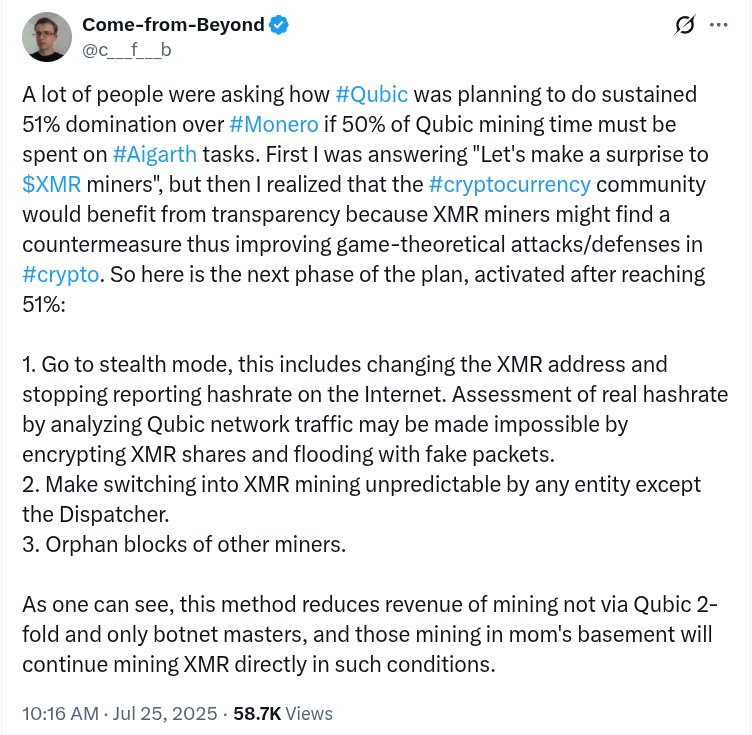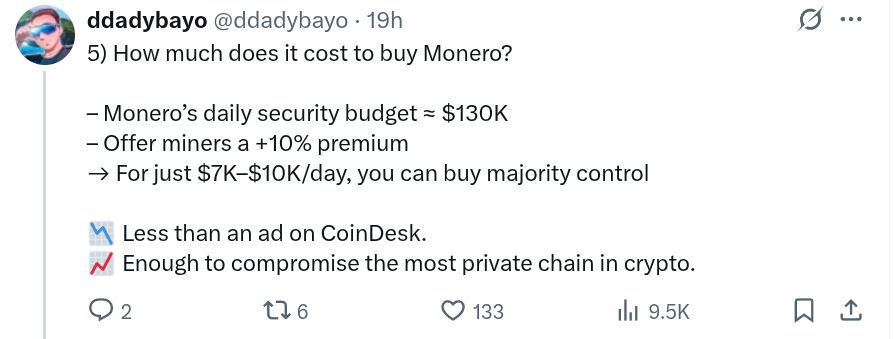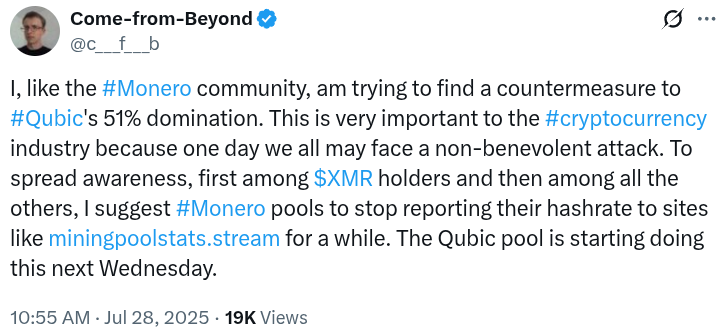Monero is currently facing a hashrate takeover attempt by the Qubic mining pool, led by Sergey Ivancheglo, which threatens network decentralization and could impact transaction confirmations and mining profitability.
-
Qubic’s hashrate plummeted from first to seventh place after community backlash.
-
Qubic incentivizes Monero CPU mining to fund its ecosystem through buybacks and token burns.
-
Experts warn that hashrate centralization increases risks of block orphaning and transaction censorship.
Monero faces a hashrate takeover attempt by Qubic, raising decentralization concerns. Stay informed on this critical crypto network development.
What is the Qubic Hashrate Takeover Attempt on Monero?
The Qubic mining pool is attempting to gain control over Monero’s hashrate by incentivizing CPU mining and rejecting blocks from competing pools. This strategy could centralize mining power, potentially disrupting transaction validation and network security.
How Did Qubic’s Mining Pool Strategy Evolve?
Qubic, led by Sergey Ivancheglo, began incentivizing Monero CPU mining to strengthen its own ecosystem via token buybacks and burns. Initially the top Monero mining pool, Qubic’s hashrate sharply declined to seventh place after community concerns about a potential network takeover emerged.

Source: Sergey Ivancheglo
Why is the Monero Community Concerned About Hashrate Centralization?
Hashrate centralization poses risks such as block orphaning, transaction delays, and censorship. Analyst Dan Dadybayo explains that if Qubic controls over 51% of Monero’s hashrate, it could reject blocks mined by others and force protocol changes, undermining network integrity.
What Are the Potential Consequences of Qubic’s Control?
Starting August 2, users may experience orphaned blocks and longer confirmation times, as Qubic plans to reject non-Qubic blocks. Despite claims of no malicious intent, experts emphasize that centralization inherently increases vulnerability to attacks and market manipulation.

Source: Dan Dadybayo
How Will Qubic’s Hashrate Reporting Changes Affect Network Transparency?
From the upcoming Wednesday, Qubic will cease reporting its hashrate, obscuring the actual mining power it controls. This lack of transparency complicates monitoring efforts and heightens concerns about hidden centralization risks within the Monero network.

Source: Sergey Ivancheglo
What Has Been the Community Response to Qubic’s Actions?
The Monero community has expressed strong backlash, with discussions highlighting fears of network manipulation and threats directed at Qubic’s leadership. Given Monero’s reputation as a privacy-focused cryptocurrency, users are wary of any centralization that could compromise its anonymity and security.
What Expert Opinions Highlight the Risks?
Experts stress that capital-driven incentives, like those used by Qubic, represent a new attack vector beyond technical exploits. Centralization risks threaten the core principles of decentralization and censorship resistance that underpin Monero’s value proposition.
| Mining Pool | Hashrate Share | Ranking Change |
|---|---|---|
| Qubic | 7th largest | Fell from 1st to 7th |
Frequently Asked Questions
What is the significance of a hashrate takeover in Monero?
A hashrate takeover means one entity controls most mining power, risking block censorship, transaction delays, and protocol manipulation, which threatens Monero’s decentralization and security.
How does Qubic’s strategy impact Monero mining profitability?
By rejecting blocks from other pools, Qubic aims to make mining profitable only within its own pool, potentially forcing miners to join Qubic to earn rewards effectively.
Key Takeaways
- Qubic’s hashrate takeover attempt threatens Monero’s decentralization: Centralized mining power risks network security and transaction integrity.
- Community backlash led to Qubic’s hashrate decline: From first to seventh largest pool, signaling resistance to takeover attempts.
- Transparency reduction increases monitoring challenges: Qubic will stop reporting hashrate, complicating risk assessment.
Conclusion
The ongoing hashrate takeover attempt by Qubic highlights critical vulnerabilities in Monero’s mining decentralization. While the community actively resists centralization, the evolving situation underscores the importance of vigilance and transparency to protect Monero’s privacy and security features. Continued monitoring and community engagement remain essential to safeguard the network’s integrity.
